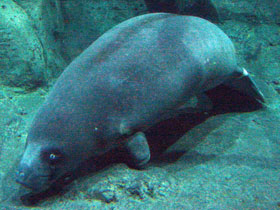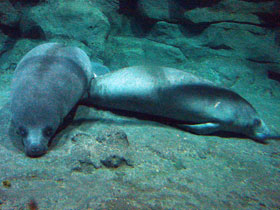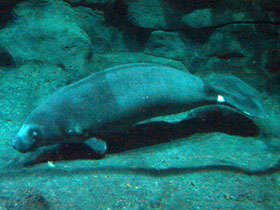The African manatee Trichechus senegalensis
African manatees are large aquatic animals with cumbersome appearance; they have streamlined body and large forelimbs equipped with the nails. The body of a manatee is tapering to a flat paddle-shaped tail. Adult African manatees can be distinguished by their greyish-brown colour; otherwise they look like American manatees. The skin of the African manatee is sparsely covered with fine hairs, with the area around the mouth featuring stout bristles (vibrissae). The manatee upper lip is split in two and the left and right sides can move independently and behave like a pair of fingers. An adult manatee has a body length of 3 to 4 meters and weighs less than 500 kg. The largest African manatee ever caught in the wild weighed about 360 kg and measured 4.5 m in body length.
African manatees occur in rivers, estuaries, and shallow quiet coastal bays, lakes and reservoirs of West Africa. The Senegal River in southern Mauritania marks the northern limit of their range, while the Cuanza River of Angola serves as the southern boundary. The populations of the African manatees that are highly important in terms of the conservation are found around the Bijagos Archipelago (Guinea Bissau), in the lagoons of Côte d’Ivoire (Ivory Cost), in the Volta Lake and Digya National Park in Ghana, the Ndogo Lagoon in Gabon, rivers and lakes of Senegal, the Sanaga River in Cameroon, lower Niger River (Nigeria), and lower Congo River.
African manatees inhabit shallow coastal waters and rivers, moving freely between salt and freshwater. They prefer calm waters rich in vegetation and avoid very salt water. Their preferred habitats are presented by costal lagoons and shallow estuaries (less than 3 meters in depth) of large rivers with abundant mangrove and grassy vegetation. African manatees were observed in the extreme upper reaches of rivers above cataracts. In riverine habitats that have major fluctuations in flow rates and water levels, manatees prefer the areas that have access to deep pools or connecting lakes for refuge during the dry season and seasonally flood into swamps or forests with abundant grasses and sedges, particularly reeds, burgu-millets, and other cereal grasses. African manatees were observed 75 km offshore among the shallow coastal flats and mangrove creeks around the Bijagós Archipelago. Isolated populations that do not have access to salt waters have been found in the Volta Lake in Ghana, above the dam of the hydroelectric power station. Another population, landlocked above the major rapids, is found in the upper Niger River as far as Segou, in over 2,000 km from the ocean, which is the furthest inland record for this species. Sightings of manatees have been reported from the Baningi, Logone and Chari Rivers tributaries of Lake Chad.
Little is known about behaviour of the African manatee. Apparently, these animals are nocturnal since they are feeding and moving mostly during the night. African manatees rest during the day in shallow water (1-2 m deep), often staying in the middle of the river or using mangroves or other vegetations as cover. African manatees were earlier thought to be able to feed on the shores but this view was not confirmed. African manatees are usually found as solitary individuals or in small family groups consisting of 2 to 6 animals. The bond of the mother and her offspring is thought to be the only strong stable social relationship between individuals.
African manatees primarily feed on aquatic vegetation, especially on plants growing along coastlines. Animals living in estuaries forage in mangroves, tearing leaves off the overhanging branches. Their diet in the wild includes Vossia sp., water hyacinth (Eichornia crassipes), Polygonum sp., hornwort (Ceratophyllum demersum), Azolla sp., Echinochloa sp., common duckweed (Lemna sp.), Myriophyllum sp., water lettuce (Pistia stratiotes), and red mangrove (Rhizophora racemosa). Considering that an adult manatee eats about 12 to 18 kg of food every day, it should be able to consume up to 8,000 kg of vegetation per year. Fishermen blame manatees for stealing small fish captured in fishermen’s nets but such facts are not confirmed. In some places the African manatee is considered a pest because it consumes planted rice. In Senegal and Gambia, shell remains of mollusks have also been found in the stomachs of caught manatees.
Reproduction in African manatees is not well-studied and most hypotheses about their breeding are based on the known ecology of the American manatees that are closely related to the African manatees. Although manatee breeding and birth may occur at any time during the year, the calving peak occurs in late spring–early summer. Females reach sexual maturity by the age of three years. Multiple males will usually mate with one receptive female.
Gestation lasts 13 months and results in the birth of one calf (twins are rare). The female gives birth to her calf in the lagoon with shallow water. Manatee baby is often born with the tail first and is able to swim on its at birth. Manatee calf nurses from the nipples located behind the mother's flippers; it suckles its mother’s milk for 12 to 18 months and stays with the mother till the age of two years. The longevity of wild African manatees is uncertain but they are thought to live past the age of 30 years. The manatees have very few natural predators; their predators include sharks, crocodiles, and alligators.


















































